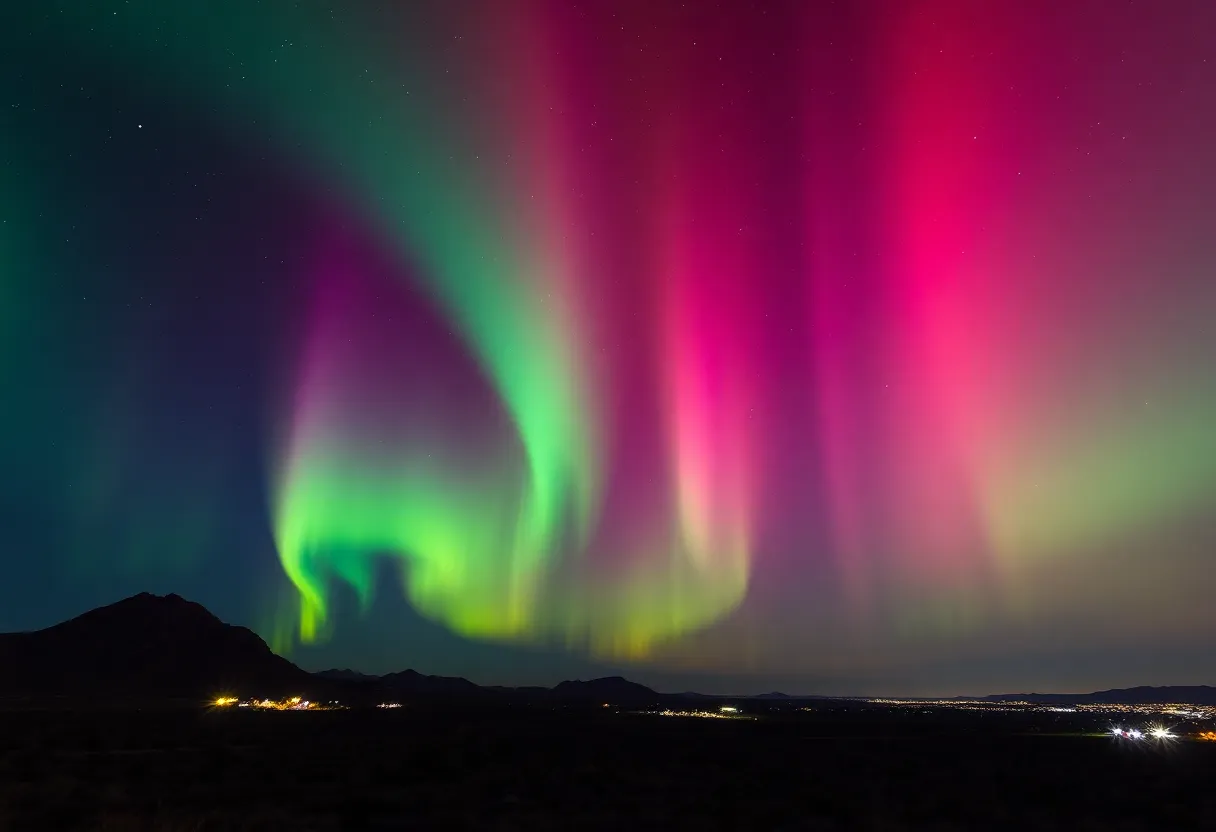Tucson, October 23, 2025
A massive solar flare erupted from the sun recently, illuminating the northern sky above Tucson with aurora-like lights. With colors resembling the aurora borealis, this dazzling spectacle surprised locals, many of whom took to social media to share their awe. Monitoring by scientists at Kitt Peak Observatory indicated that a coronal mass ejection could lead to more geomagnetic activity. While minor radio blackouts were warned, the night remained largely unimpacted, allowing residents to enjoy one of the most remarkable celestial events visible in their area.
Tucson, AZ – Stunning Solar Flare Lights Up Northern Sky Over City
Tucson, AZ (October 23, 2025) – A massive solar flare erupted from the sun late Tuesday, creating a breathtaking display of aurora-like lights visible across Tucson and sparking awe among residents who captured the spectacle on social media. Scientists at the nearby Kitt Peak Observatory closely monitored the event, which involved a powerful coronal mass ejection (CME) that could lead to enhanced geomagnetic storms through the weekend, offering more opportunities for skywatchers.
The solar flare, classified as significant by experts tracking solar activity, originated from an active region on the sun’s surface and released a burst of energy that rippled through space. In Tucson, the effects manifested as shimmering lights resembling the aurora borealis, typically seen much farther north, dancing in the northern sky around midnight. Local residents reported seeing greens, purples, and reds streaking across the horizon, turning an ordinary night into a rare natural light show.
Monitoring and Potential Impacts
At Kitt Peak Observatory, located just west of Tucson, researchers used advanced telescopes and instruments to observe the flare in real time. The observatory’s team noted the accompanying CME, a massive cloud of solar particles and magnetic fields hurled toward Earth at speeds exceeding a million miles per hour. Upon reaching our planet, these ejections can interact with Earth’s magnetic field, triggering geomagnetic storms.
Authorities issued warnings about potential radio blackouts due to the flare’s interference with high-frequency communications, particularly affecting aviation and maritime operations. However, no major disruptions have been reported in the Tucson area or nationwide as of early Thursday morning. Power grids and satellite systems remain stable, though experts advise continued vigilance for minor disturbances through the weekend.
Community Reaction and Viewing Tips
Social media platforms lit up with photos and videos from Tucson residents, many of whom stayed up late to witness the phenomenon. The unexpected visibility of aurora-like displays in southern Arizona, far from the usual polar regions, surprised and delighted locals, with some describing it as one of the most vivid celestial events they’ve seen.
With the CME expected to fuel stronger geomagnetic activity into the weekend, stargazers in Tucson are encouraged to look north after sunset, away from city lights, for potential repeat viewings. Clear skies, forecasted for the region, should provide optimal conditions. Experts recommend using a camera or smartphone with night mode to capture the faint lights, as the human eye may need time to adjust to the darkness.
Understanding Solar Flares and Their Effects
Solar flares are sudden explosions of radiation from the sun’s atmosphere, often linked to sunspots and magnetic activity during the solar cycle. This event is part of the sun’s current approach to its maximum activity phase, expected around 2025, which brings more frequent and intense eruptions. While spectacular, these flares can pose risks: in addition to radio blackouts, strong geomagnetic storms from CMEs might cause auroral displays at lower latitudes like Tucson, but they could also disrupt GPS signals, power networks, or even induce currents in long transmission lines.
Historically, Tucson‘s dark skies and proximity to observatories like Kitt Peak make it an ideal spot for such events. The observatory, operated by the National Optical-Infrared Astronomy Research Laboratory, plays a key role in studying solar phenomena, contributing data that helps predict and mitigate space weather impacts. This flare’s visibility underscores the interconnectedness of solar activity and life on Earth, reminding residents of the sun’s dynamic influence beyond daylight hours.
As monitoring continues, no immediate threats are anticipated, allowing Tucson to enjoy the rare show. The event highlights the beauty of astronomy accessible even in urban settings, drawing attention to the ongoing solar maximum that promises more wonders in the coming months.
FAQ
What happened with the solar flare in Tucson?
A massive solar flare erupted from the sun late Tuesday, visible from Tucson as aurora-like lights danced in the northern sky.
Where was the solar flare monitored?
Scientists at Kitt Peak Observatory monitored the event, warning of potential radio blackouts.
Were there any disruptions from the solar flare?
No major disruptions reported locally.
How did residents react to the solar flare?
Residents captured stunning photos on social media.
What is expected after the solar flare?
The coronal mass ejection could enhance geomagnetic storms through the weekend, offering more viewing opportunities for stargazers.
Key Features of the Solar Flare Event
| Feature | Description |
|---|---|
| Event Type | Massive solar flare with coronal mass ejection |
| Location Visibility | Northern sky over Tucson, AZ |
| Monitoring Site | Kitt Peak Observatory |
| Potential Effects | Radio blackouts; enhanced geomagnetic storms through weekend |
| Local Impact | No major disruptions reported |
| Public Engagement | Aurora-like lights; photos shared on social media; viewing opportunities for stargazers |
Deeper Dive: News & Info About This Topic
HERE Resources
Solar Activity Spikes in Tucson




